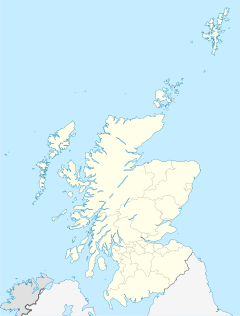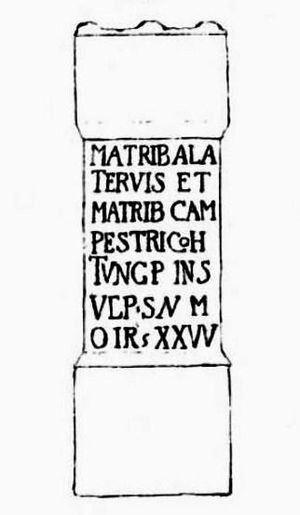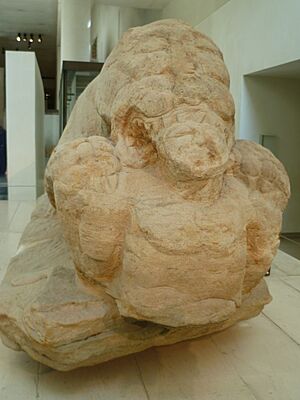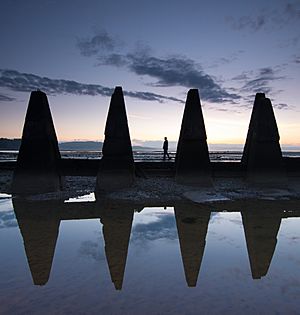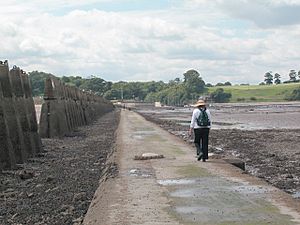Cramond facts for kids
Quick facts for kids Cramond Village
|
|
|---|---|
 Cramond Harbour |
|
| Population | 13,409 (2024) |
| OS grid reference | NT18667629 |
| Council area |
|
| Country | Scotland |
| Sovereign state | United Kingdom |
| Post town | EDINBURGH |
| Postcode district | EH4 |
| Dialling code | 0131 |
| Ambulance | Scottish |
| EU Parliament | Scotland |
| UK Parliament |
|
| Scottish Parliament |
|
Cramond Village (pronounced CRAM-und) is a lovely village and part of the city of Edinburgh, Scotland. It sits in the north-west of Edinburgh, right where the River Almond flows into the Firth of Forth.
This area has a very long history. People lived here as far back as the Mesolithic Stone Age. There is also evidence of Bronze Age and Roman activity. A famous Scottish economist named John Law (1671–1729) was born in Cramond. The village became part of the City of Edinburgh in 1920.
Contents
What's in a Name? The History of Cramond's Name
For a long time, people thought the Cramond Roman Fort was called Alaterva by the Romans. This idea came from a stone altar found near Cramond House. The altar was dedicated to "Alatervan Mothers."
However, experts now believe "Alatervae" was likely the name of the gods, not the place. It might have come from the Tungrian soldiers who set up the altar.
After the Romans left, the Votadini people lived here. They spoke Cumbric, a Celtic language. They gave Cramond its name. The name Cramond comes from Caer Amon. This means 'fort on the river'. It refers to the Roman fort located on the River Almond.
Exploring Cramond's Past: A Journey Through Time
Ancient Times: Early Human Settlements
Life Before the Romans: Mesolithic Hunters
Archaeologists have found signs of people living in Cramond around 8500 BC. This makes it one of the oldest known places where humans settled in Scotland. The people living here during the Mesolithic period were hunter-gatherers. They moved around to find food depending on the season.
Even though no bones survived, archaeologists found pits and holes for shelters. Many discarded hazelnut shells were found, which helped date the site. It's thought that people chose this spot because it was near the Firth of Forth and the River Almond. This area had lots of oysters and mussels, which were a good food source. Many small stone tools called microliths were also found here.
The Roman Era: A Fort on the River Almond
Around 142 AD, Roman soldiers arrived in Cramond. The Emperor Antoninus Pius ordered them to build a fort at the mouth of the River Almond. This fort was meant to protect the eastern side of the Antonine Wall. The Antonine Wall was a fortified border the Romans built across Scotland.
Nearly 500 men worked to build the fort. It covered about six acres and had a harbour for boats. However, the Romans only stayed for about 15 years. They were then ordered to move south to Hadrian's Wall. Later pottery and coins show that the fort was used again between 208 and 211 AD. This was when Emperor Septimius Severus used it as a base for his army and navy.
The local church, Cramond Kirk, was later built inside the Roman fort.
Discovering the Roman Fort and the Cramond Lioness
People knew the Romans had been in Cramond, but the fort itself was only found in 1954. Archaeologists did a lot of research to understand what the fort looked like. It was a rectangle with 15-foot-high walls. There was a gatehouse on each side.
Inside the fort, there were places for soldiers to sleep, workshops, and a commander's house. Later digs found other buildings outside the fort. These included a bath-house and more workshops.
In 1997, a local boatman found the amazing Cramond Lioness statue in the harbour mud. It's a sandstone statue of a lioness eating a man. It was probably one of two statues at a military commander's tomb. After being cleaned up, it was displayed at the National Museum of Scotland in Edinburgh. It is one of the most impressive Roman sculptures found in Scotland.
Medieval Times: After the Romans
Not much is known about Cramond for several centuries after the Romans left. It's a bit of a mystery!
Cramond Tower is an old tower house from the early 1400s. It was once a manor house for the Bishops of Dunkeld. In the 1980s, it was made safe and turned into a private home.
Modern Cramond: From Industry to Suburb
Cramond grew slowly over many centuries. Cramond Kirk church was founded in 1656. For a short time in the late 1700s and early 1800s, it was an industrial village. But by the late 1800s, it became a popular suburb of Edinburgh. It remains a desirable place to live today.
Cramond officially became part of Edinburgh on 1 November 1920.
Cramond's Landscape: Where River Meets Sea
Cramond is in northwest Edinburgh, about 5 miles (8 km) from the city centre. It's located where the River Almond flows into the Firth of Forth.
Historically, the area of Cramond was much larger. It stretched from the Firth of Forth to the parish of Corstorphine. It included villages like Granton, Muirhouse, and Davidson's Mains.
The land in Cramond is mostly flat and gently rolling. It slopes down from Corstorphine hill to the shore. The River Almond flows through it, heading north into the Forth. The river banks are often steep and wooded.
During the last ice age, glaciers covered the area. This left rock deposits on the east side of landforms. Before the Cramond promenade was built in the 1930s, large rocks from the glaciers were scattered along the shore.
The rocks in Cramond are mostly calciferous sandstone. This mixes with other rock layers to create the area's unique chocolate-brown soil. You can even see a coal seam near the beach on the southwest side of the River Almond estuary.
On the coast, west of the River Almond, is Hunter's Craig or Eagle Rock. It has a carving that people believe is an eagle. The carving is very old and weathered now.
Art and History: Landmarks and Sculptures
A large, 8-tonne sculpture called Fish was placed permanently on the Waterfront at Cramond in 2009. The local community worked hard to make this happen. It pays tribute to the eight months the sculptor Ronald Rae spent carving it in 2002.
The Cramond Kirk Church Hall also has a smaller sculpture called the Cramond Fish. In the car park behind the Kirk Hall, another sculpture of an elephant is being created.
Cramond's Buildings: Old and New
The older houses along the wharf are typical of traditional Scottish buildings. They are made of stone with white plaster and have stone around the windows and doors. They also have distinctive crow-step gables and orangey-red roof tiles from the Netherlands.
Further up the Almond river, you can find a ruined water mill. There's a nice walk past a yacht club and boats moored in the river. To the east, a sandy beach and waterfront path are popular for walks to Silverknowes and Granton. On the other side of the Almond, you can walk through Dalmeny Woods along the shore of the Firth of Forth.
In the Church of Scotland churchyard, there is a rare morthouse. This was a building used to protect graves from body snatchers in the past.
Near the church stands the impressive Cramond House. Its main part is from the late 1600s. A classical front was added in 1778, and the back in 1820. Queen Victoria even visited it! Some people think it might be the original "House of Shaws" from R. L. Stevenson’s book Kidnapped. It is now owned by the Church of Scotland.
The Manse, where the minister lives, is from the mid-1600s and was rebuilt in the mid-1700s. Reverend Walker, who was the model for the famous "Skating Minister" painting by Henry Raeburn, lived here from 1776 to 1784.
Off the coast, Cramond Island has old WW II forts. It's connected to the mainland by a causeway. This causeway has a line of concrete pylons that were built to stop enemy ships. At low tide, you can walk across the sand to the island. But be careful! The tide comes in quickly, and people sometimes get stuck.
Cramond in Stories and TV
Cramond is mentioned in a few famous stories:
- It's linked to The Prime of Miss Jean Brodie. Mr. Lowther lives here, and Miss Brodie spends time in Cramond.
- The "House of Shaws" in Robert Louis Stevenson's Kidnapped is located in Cramond.
- Ian Rankin's book Fleshmarket Close also mentions Cramond.
Cramond also appeared briefly in a 1970 episode of the TV show Paul Temple (TV series) called 'Double Vision'. More recently, it was featured in Young Sherlock Holmes: Fire Storm.
Famous People from Cramond
Many interesting people have lived in Cramond:
- Russell Barr, a Minister and former leader of The Church of Scotland.
- Campbell Maclean, a Minister.
- David Bruce (minister)
- John Chesser (architect), buried in Cramond Kirkyard.
- Sir William Edmonstone
- Sir John Inglis, 2nd Baronet
- Rev George Muirhead (1764–1847), a minister in Cramond.
- James Stuart (1775–1849), a politician.
- Rev. Leonard Small, a leader of the General Assembly.
- Robert Walker (clergyman), the model for the famous "Skating Minister" painting.
- John Philip Wood
- John Law (economist), a famous Scottish economist.
- J. K. Rowling, the author of the Harry Potter books.
Images for kids


